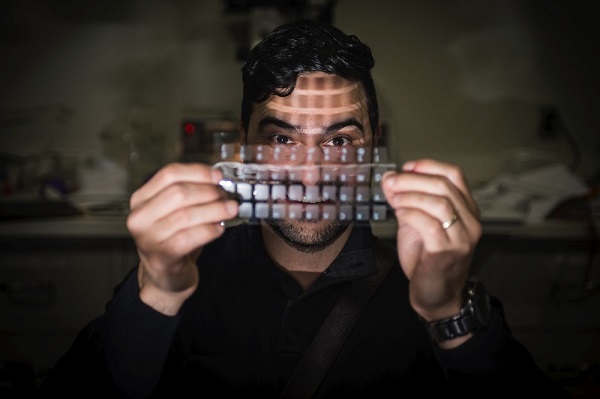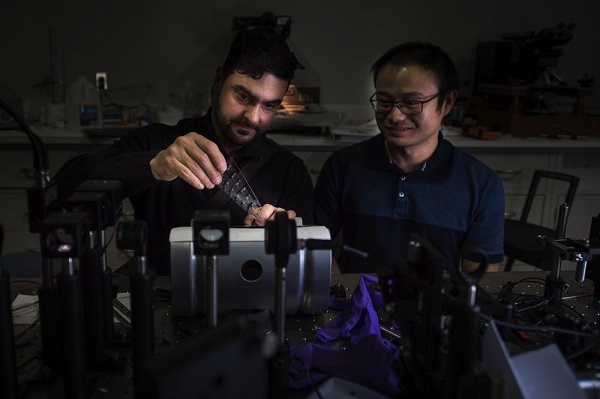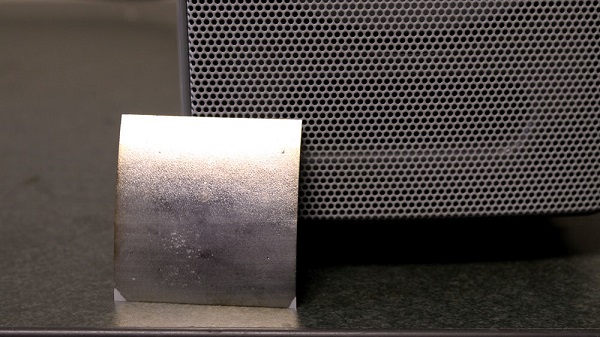Researcher turns a banner into a speaker
In December of last year, researchers from Michigan State University demonstrated their "ferroelectret nanogenerator" technology, abbreviated as "FENG". It allows thin, paper-like devices to generate energy through motion. But now, researchers have found a new use - using FENG technology to create a thin, flexible microphone or speaker. The key is to use a charged ion layer that can "convert mechanical energy into electrical energy," or use it in reverse.

Using ferroelectret nanogenerator (FENG) technology, researchers turned the banner in the upper right corner into a speaker.
In previous tests, the research team used a finger to slide or touch the electrical signals generated to drive a keyboard, touch screen, or LED lights. But they soon realized that this system was very sensitive enough to receive the vibrations generated by the sound and was an efficient choice for making microphones.

Previous work has found that FENG materials can be used to make flexible keyboards that use finger clicks to generate electricity.
During the test, the research team sent an “Anwar Patch†to the FENG material, connected it to a computer, and used it as a “speech recognition lockâ€. It was found that the accuracy of this system is high enough to distinguish different users.

The material is expected to be used on flexible speakers/microphones to create a "talking newspaper."
In addition, in view of its ability to turn electrical energy back into mechanical energy, this system can also create a loudspeaker. For example, embedding it in a banner and then connecting an iPad or a power amplifier can effectively sing a tune.

ENG materials can convert mechanical energy to electrical energy (and vice versa) and can be used for speakers or microphones.
Nelson Sepulveda, the project's chief researcher, said that in the future, everyone is expected to use a more flexible, light-weight, and small device instead of a large, heavy, and energy-consuming speaker.
For more details on this study, please read the recent issue of Nature Communications. In addition, the research team also presented and explained in the above video.
Plate rolling is a process of continuous three-point bending of sheet metal using a plate rolling machine. The equipment puts the sheet material between the upper and lower work rolls when rolling. The upper roller is raised and lowered vertically, and the two lower rollers rotate and move horizontally relative to the axis of the upper roller. When the upper roll descends, the plate is plastically deformed and bent between the upper and lower work rolls. The continuous rotation of the bottom roller drives the steel plate to advance and retreat through the friction between the plate and the roller to complete the coiling.
1. Pre-bending. When the plate is rolled, there is a length at both ends of the plate that does not bend because it does not touch the upper roller. It is called the remaining straight edge. In the process, the minimum force arm at which the plate starts to bend is called the theoretical remaining straight edge. The bending form (symmetrical bending, asymmetrical bending) is related.
2. Centering. The purpose of centering is to make the generatrix of the workpiece parallel to the roller axis to prevent skew.
3. Roll round. Rolling is the main process of product forming, which is divided into two types: one-time feed and multiple feeds. Multiple feeds are commonly used for rolling thick plates. The number of feeds depends on the technological constraints (such as the maximum allowable deformation during cold rolling) and equipment constraints (such as non-slip conditions and power conditions). When the rebound of the cold coil is significant, a certain amount of overcoiling must be added.
4. Straightening round. The purpose of rounding is to make the curvature of the entire circle as uniform as possible to ensure product quality. The general rounding process is divided into three steps:
(1) Load: According to experience or calculation, adjust the work roll to the position of the required maximum correction curvature.
(2) Rounding: Roll the roller 1 to 2 turns under the corrected curvature to make the entire curling rate uniform.
(3) Unloading: gradually unload the load, so that the workpiece is rolled several times under the gradually reduced correction load.
Rolling Machine,Three-Roller Bending Machine,Four-Roller Bending Machine,Roll Forming Machine
Rugao Yaou Import & Export Trade Co., Ltd , https://www.ntyaou.com